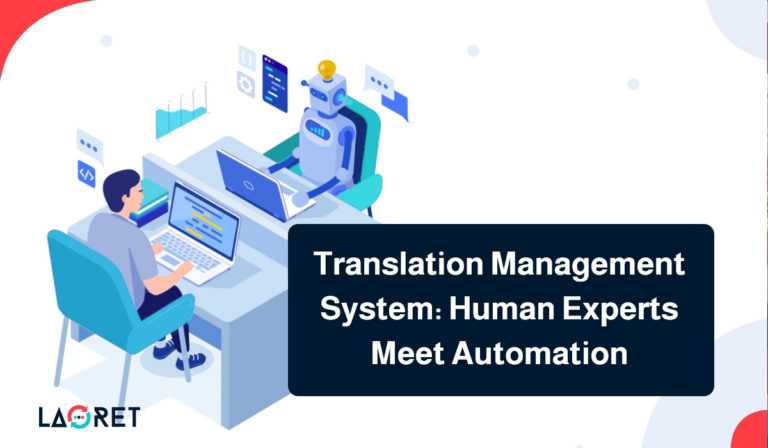Translation Management System: Human Experts Meet Automation
Translation projects can be complex! You have obviously heard that thrown around here and there, but its never really clear where that complexity lies.
Translation projects involve multiple components: human resources (translators, reviewers, QA specialists, designers, and project managers), translation tools and technology, and budget and schedule constraints. A translation project also goes through multiple phases, from preparing the source files for translation to the delivery of the translated files in the format required.
And while there are a lot of translation tools on the market that will help streamline the translation process and manage teams effectively. A Translation Management System (TMS) comes at the top of them. It makes it possible for everyone involved to collaborate seamlessly, for your content to be efficiently handled, and for the entire process to be managed with ease and intricacy, all while allowing you to run the show.
In this blog, we will be taking you through the ins and outs of the TMS and explore what a TMS is, what the benefits are of using one, exactly which steps you should take to select your TMS, and if it will be the best for you to get your own TMS, or connect with a Language Service Provider (LSP) instead.
What Is A Translation Management System?
A Translation Management System (TMS) is a type of software, designed to optimize the translation process. Whether your business requires a large amount of translated content regularly or runs multiple translation projects at once, so much time and effort go into that, making things overwhelming for you. Thats where a TMS comes in handy.
Between optimizing the translation process through partial automation and streamlining workflows to optimizing communication between collaborators, the benefits are too many to list in just a few lines.
So, we are dedicating the next section to expanding on the benefits that TMS brings to your translation projects.
Key Benefits Of A Translation Management System

Automation
One of the most profitable perks of a Translation Management System is the fact that it can automate repetitive processes that would otherwise take a lot of time and effort. Here is a glimpse of the numerous, time-consuming activities that are typically involved in a translation project, and that a TMS helps you automate and minimize to a great extent:
- Project creation
- Quotations
- Resources allocation and task assignment
- Project requirements communication
- File sharing
- File format conversion
- Follow-ups and email exchanging
- Feedback and reporting… and more
Now, imagine doing all that for each translation project you have!
In a traditional setting, collaborators carry out these activities that take up too much time of their time (and your projects time), which can be distracting from their core responsibilities and cause delays in project delivery.
However, in a single platform thats TMS, you can manage an unlimited number of translation projects (whether different content or the same content for different languages and dialects). The entire process will be automated and organized, eliminating the back-and-forth hassle and time-wasting, manual workflows.
An efficient TMS also has key automation features that you should know about so you can make the most of them
- Automatic Importing and Exporting of resource files. Traditionally, youll need someone to handle your resource files. When you have a website localization project, for instance, youll need to copy and paste a huge number of strings. But thats not exactly the practical way to do it. An efficient TMS offers seamless import and export functionality that supports various file formats and automatically identifies and pulls content for translation.
- Optimizing the Translation Process. To guarantee the utmost quality, a translation project typically goes through multiple review cycles including editing, proofreading, and final QA review. And if done manually, the process takes a significant amount of time, going back and forth between revisions, edits, and feedback. This might even get far more complicated, if your project requires back translation, for instance. But thats exactly the reason why a TMS can be a huge benefit.It streamlines the translation process and facilitates real-time collaboration and communication between your teams. For instance, translators, reviewers, and project managers receive notifications to take over the work. They can upload, store, and download files, all from one place. Also, with private messaging and project management tools, you can coordinate efforts between everyone, increase the productivity of the team, and track the progress of the project.
- Continuous Translation. The consistent flow of importing and exporting content will also support the process of continuous localization. With mobile app localization, for example, updates in features and content are very common. In order to make it all run smoothly, a TMS will regularly import, translate, and export your content.
Integration
The power of a TMS doesnt only lie in its automation features, but also in its integration features. Perhaps the most prominent integration that a translation management system supports is Computer-Assisted Translation (CAT) Tools. These tools are vital to delivering consistent, qualitative, and affordable translations, especially for larger projects. How? The CAT Tool consists of the following assets.
Third-Party Integrations
A top-of-the-line TMS will also allow for third-party integrations which include:
- Design Tools used by the Desktop Publishing Team (e.g. Adobe InDesign). Desktop Publishing Experts will be able to access editable versions of your designs and more easily tweak the multilingual versions as needed.
- CMS Tools (WordPress, Drupal…etc.). This integration will make it easier to import and export content. It can also prove useful when you want to receive a quote, as the LSP will be able to calculate the rate based on an exact word count.
- Engineering Tools (e.g. Jenkins, Grunt, Docker…etc.) These will effectively support the continuous localization process and provide access to automated software development assets.
- Workflow Tools (think Trello or Asana) so that all communication channels can be streamlined and all stakeholders will be kept up to date.
- Code Repositories (GitHub, GitLab…etc.) where the localization professionals can easily access all documentation related to the translation project.
Collaboration
A Translation Management System is optimized with Project Management Assets which supports a collaborative environment where the entire translation team can work from a single platform.
While the TMS was initially intended to support the work of linguists, it has since become a valuable tool for Project Managers to maintain optimal collaboration across different departments.
The Translation Management System will offer a host of analytics that can prove indispensable when organizing a team and keeping track of translation projects. These commonly work on three levels, which are:
- Team level analytics that monitors all levels of user activity including the number of projects that are created and their timelines.
- Project level analytics help Project Managers understand who is involved in every project and how close this project is to completion.
- Translation Analytics where things such as word count and translator profiles can be tracked.
Data Protection
Since highly sensitive information may be communicated through the TMS, data protection is a priority. A TMS can provide a secure workspace. You can rest assured all data are securely stored on cloud servers. Additionally, a TMS helps keep all your payment information highly secure and safe in one place.
Tips On Selecting The Best Translation Management System
It is all good and well to know how a Translation Management System can benefit you, but how can you find the one that best suits your needs? If you need some insights into what you should pay attention to when choosing a TMS, and whether it will be an extensive, more costly version, it will depend on the following:
- The volume of the multilingual projects and content assets you need to be managed
- The number of platforms your business uses, such as apps and websites, and whether they will need localizing.
- How many regions you intend to expand into and the number of languages you will be translating into
- The size of your team and whether additional management tools are required to organize them.
When you are ready to make a selection, here are some top tips to get started!
- Bring together the team of stakeholders that will be using the TMS and also be in charge of signing off on it. It is important that everyone involved in either working with the Translation Management Software or financing it has a say in the matter.
- Draw up a list of features you require from a TMS and which goals you need to achieve with it. Here too, let all stakeholders provide input on what matters most to them. To make it easier, have each stakeholder apply a numeric value to the items they are putting on the list (for example 1-5) in case some tough decisions will need to be made.
- Next, research the options out there and create a shortlist of the ones that include the features you have prioritized. For a clear overview of the Translation Management Systems out there, have a look at Nimdzis TMS Feature Explorer.1 In this extensive list, you can organize the tools by different criteria such as accepted file formats, collaboration, quality, and so on.
- Next, the selected TMS vendors should set up a demo for you to preview so you can see the tool in action.
- If you like what you see, you can go ahead and request a free trial for yourself. So, you will see exactly how your team will work with the TMS and if it meets your expectations.
- Finally, you should consider all your options and decide. Make sure that when taking your decision, you keep your feature list in mind and the numeric system you attributed to them in case the choice will be difficult!
Should You Partner Up With An LSP With A Translation Management System?
Perhaps you think taking all of these steps for yourself can be quite a hassle. After all, there are LSPs out there that already have a TMS and will have optimized it for all kinds of projects. If you are on the fence about this, we invite you to think about your goals. An LSP will certainly have everything done and ready for you and will be able to provide all the connectors you need between your system and theirs.
Additionally, they will already have a skilled team of Project Managers, Translators, and Localization Engineers in place that will know exactly how to work with the tool. If you are translating into multiple languages, you will inventively be hiring freelance translators for shorter periods of time, and they may be faced with a learning curve. So, make sure you consider what will be the best choice for you before moving ahead!
Conclusion
A TMS is a vital tool for managing translation services effectively. They can automate part of the translation and localization process, allow team members to work together in harmony, and optimize the translation workflow from start to finish. While some prefer to get a TMS for their own business and manage teams from there, others see more benefit in connecting with an LSP where translation services are already fully optimized in them.
At Laoret, we develop our own tools and leverage an optimized Translation Management System where we can combine high turnaround times thanks to partial automation with a stellar team.
Want to get started on your translation project today? Request a quote today!
References
https://www.nimdzi.com/tms/






